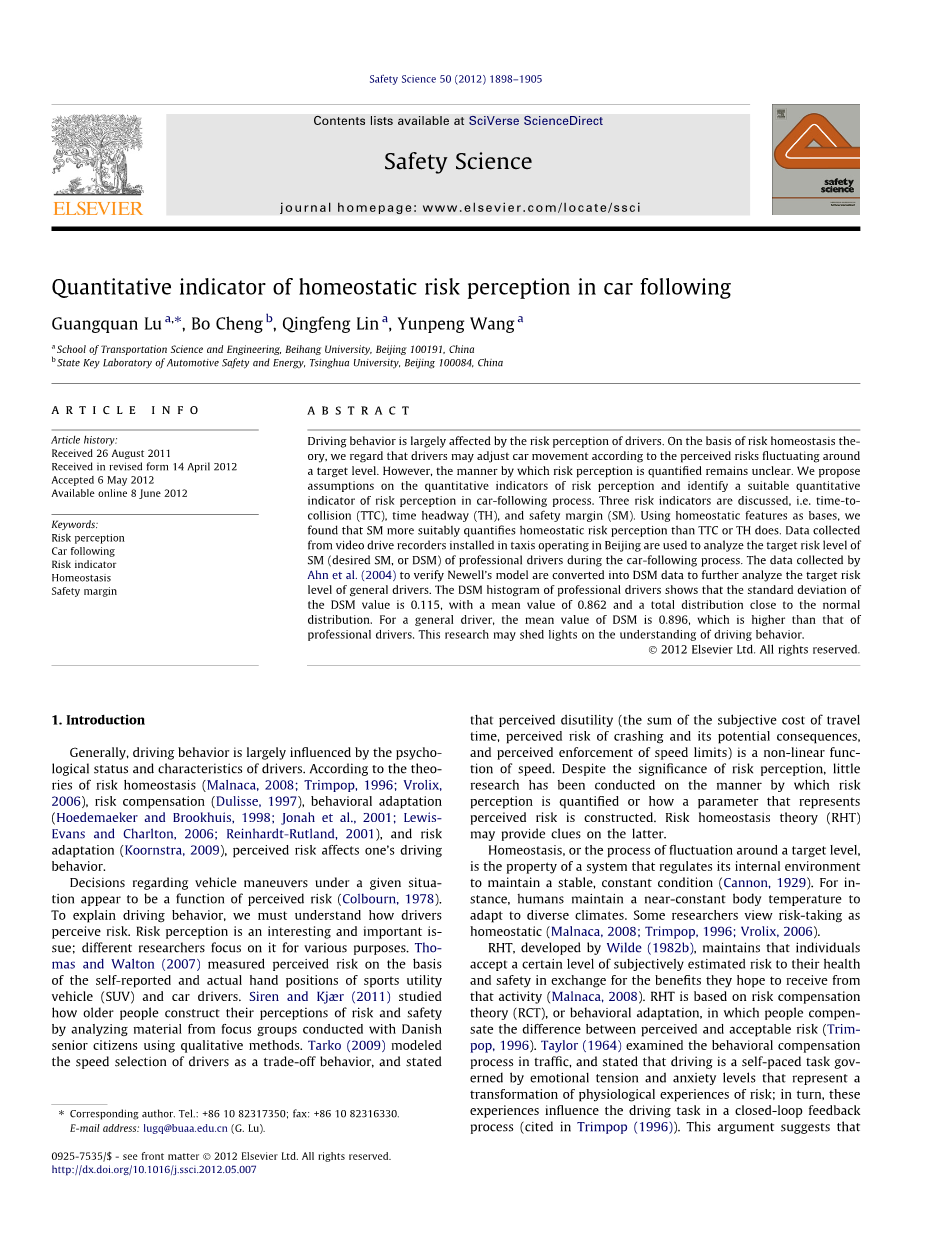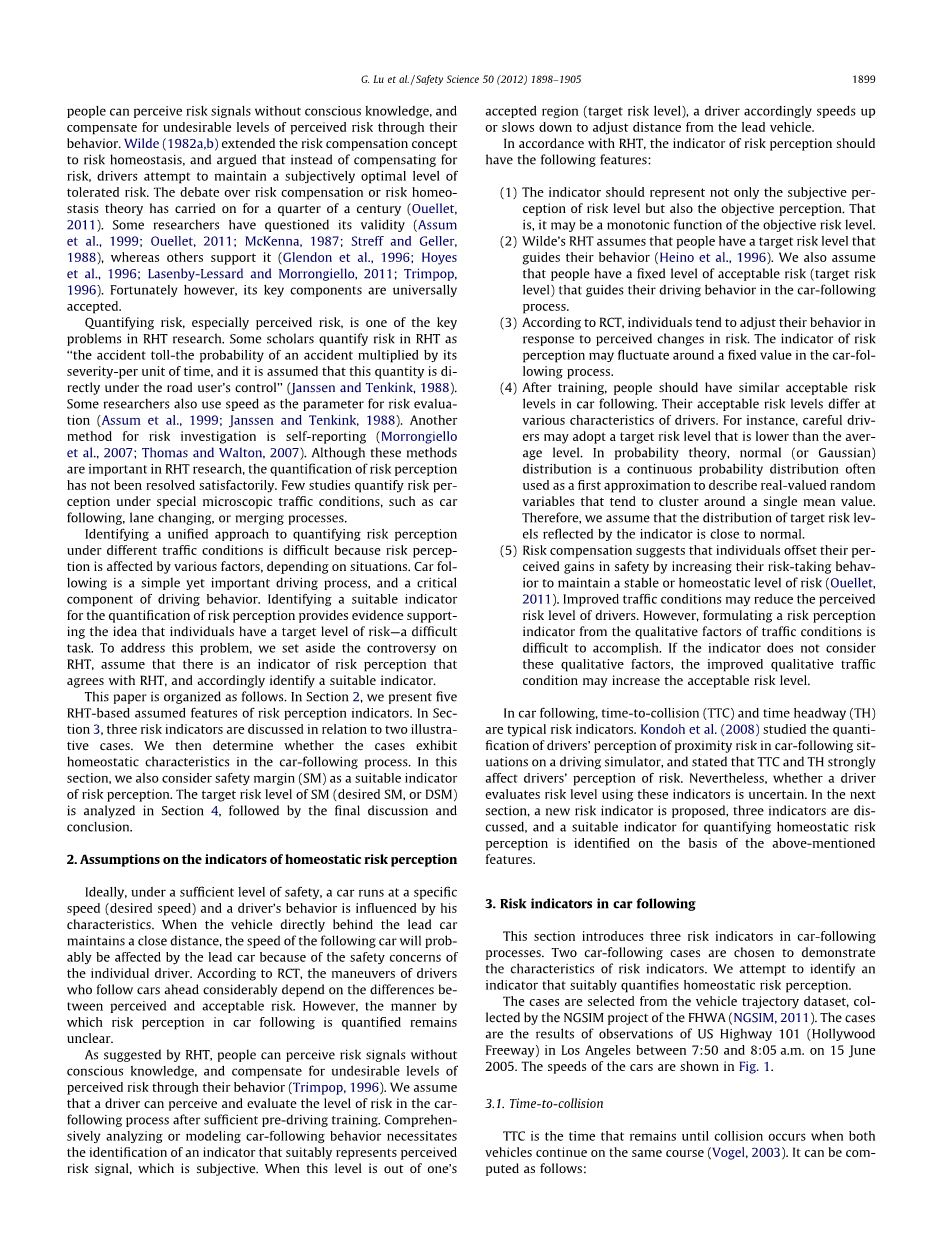

英语原文共 8 页
Quantitative indicator of homeostatic risk perception in car following
Guangquan Lua, Bo Chengb, Qingfeng Lina, Yunpeng Wanga
a School of Transportation Science and Engineering, Beihang University, Beijing 100191, China
b State Key Laboratory of Automotive Safety and Energy, Tsinghua University, Beijing 100084, China
abstract
Driving behavior is largely affected by the risk perception of drivers. On the basis of risk homeostasis theory, we regard that drivers may adjust car movement according to the perceived risks fluctuating around a target level. However, the manner by which risk perception is quantified remains unclear. We propose assumptions on the quantitative indicators of risk perception and identify a suitable quantitative indicator of risk perception in car-following process. Three risk indicators are discussed, i.e. time-to-collision (TTC), time headway (TH), and safety margin (SM). Using homeostatic features as bases, we found that SM more suitably quantifies homeostatic risk perception than TTC or TH does. Data collected from video drive recorders installed in taxis operating in Beijing are used to analyze the target risk level of SM (desired SM, or DSM) of professional drivers during the car-following process. The data collected by Ahn et al. (2004) to verify Newellrsquo;s model are converted into DSM data to further analyze the target risk level of general drivers. The DSM histogram of professional drivers shows that the standard deviation of the DSM value is 0.115, with a mean value of 0.862 and a total distribution close to the normal distribution. For a general driver, the mean value of DSM is 0.896, which is higher than that of professional drivers. This research may shed lights on the understanding of driving behavior.[1]
copy;2012 Elsevier Ltd. All rights reserved.
汽车跟随中稳态风险感知的定量指标
Guangquan Lua,Bo Chengb,Qingfeng Lina,Yunpeng Wanga
a 北京航空航天大学交通科学与工程学院,北京100191
b 清华大学汽车安全与节能国家重点实验室,北京100084
摘要
驾驶行为在很大程度上受驾驶人风险感知的影响。在风险稳态理论的基础上,我们认为驾驶人可以根据在目标水平附近波动的感知风险来调整汽车运动。然而,风险感知量化的方式仍不清楚。我们提出了风险感知量化指标的假设,并确定了跟车过程中风险感知的合适量化指标。讨论了三个风险指标,即碰撞时间(Time-to-Collision, TTC),车头时距(Time-Headway, TH)和安全裕度(Safety-Margin, SM)。使用稳态特征作为基础,我们发现SM比TTC或TH更适合量化稳态风险感知。从在北京运营的出租车中安装的视频记录器收集的数据用于分析在跟车过程中专业驾驶人的安全裕度(期望的安全裕度(desired SM或称作DSM))。被Ahn等(2004)收集的数据将用来验证Newell的模型是否转换为目标安全等级(Desired Safety Margin,DSM)数据,以进一步分析一般驾驶人的目标风险等级。专业驾驶人的DSM直方图显示DSM值的标准偏差为0.115,平均值为0.862,总分布接近正态分布。对于一般驾驶人,DSM的平均值为0.896,高于专业驾驶人的平均值。这项研究可能会对驾驶行为的理解有所启发。[2]1
copy;2012 Elsevier Ltd保留所有权利
1.Introduction
Generally, driving behavior is largely influenced by the psycho-logical status and characteristics of drivers. According to the theories of risk homeostasis (Malnaca, 2008; Trimpop, 1996; Vrolix, 2006), risk compensation (Dulisse, 1997), behavioral adaptation (Hoedemaeker and Brookhuis, 1998; Jonah et al., 2001; Lewis-Evans and Charlton, 2006; Reinhardt-Rutland, 2001), and risk adaptation (Koornstra, 2009), perceived risk affects onersquo;s driving behavior.
1.简介
通常,驾驶行为在很大程度上受驾驶人的心理状态和特征的影响。根据风险稳态理论(Malnaca,2008;Trimpop,1996;Vrolix,2006),风险补偿(Dulisse,1997),行为适应(Hoedemaeker和Brookhuis,1998;Jonah等,Lewis-Evans和Charlton,2006;Reinhardt-Rutland,2001年)和风险适应(koornstra,2009),感知风险会影响驾驶人的驾驶行为。
Decisions regarding vehicle maneuvers under a given situation appear to be a function of perceived risk (Colbourn, 1978). To explain driving behavior, we must understand how drivers perceive risk. Risk perception is an interesting and important is-sue; different researchers focus on it for various purposes. Thomas and Walton (2007) measured perceived risk on the basis of the self-reported and actual hand positions of sports utility vehicle (SUV) and car drivers. Siren and Kjaelig;r (2011) studied how older people construct their perceptions of risk and safety by analyzing material from focus groups conducted with Danish senior citizens using qualitative methods. Tarko (2009) modeled the speed selection of drivers as a trade-off behavior, and stated that perceived disutility (the sum of the subjective cost of travel time, perceived risk of crashing and its potential consequences, and perceived enforcement of speed limits) is a non-linear function of speed. Despite the significance of risk perception, little research has been conducted on the manner by which risk perception is quantified or how a parameter that represents perceived risk is constructed. Risk homeostasis theory (RHT) may provide clues on the latter.
在给定情况下关于车辆操纵的决定似乎是感知风险的函数(Colbourn,1978)。为了解释驾驶行为,我们必须了解驾驶人如何认知风险。风险认知是一个有趣而重要的课题;不同的研究人员将其用于各种目的。Thomas和Walton(2007)根据运动型多功能车(SUV)和汽车驾驶人的自我报告和实际手部位置测量感知风险。Siren和Kjaelig;r(2011)通过分析丹麦老年人使用定性方法进行的焦点小组的材料,研究了老年人如何构建他们对风险和安全的看法。Tarko(2009)将驾驶人的速度选择建模为权衡行为,并说明感知到的负效用(旅行耗费时间的主观感受,感知到的事故风险及其潜在后果的总和,以及速度限制带来的感知上的强制力)是速度的非线性函数。尽管存在风险感知的重要性,但很少有关于风险感知量化方式或如何构建代表感知风险的参数的研究。风险稳态理论(RHT)可以为后者提供线索。
Homeostasis, or the process of fluctuation around a target level, is the property of a system that regulates its internal environment to maintain a stable, constant condition (Cannon, 1929). For in-stance, humans maintain a near-constant body temperature to adapt to diverse climates. Some researchers view risk-taking as homeostatic (Malnaca,2008; Trimpop,1996; Vrolix,2006).
稳态或围绕目标水平的波动过程是一个系统调节内部环境维持稳定,恒定的条件(Canon,1929)。例如,人类保持接近恒定的体温以适应不同的气候。一些研究人员将冒险行为视为稳态(Malnaca,2008;Trimpop,1996;Vrolix,2006)。
RHT, developed by Wilde (1982b), maintains that individuals accept a certain level of subjectively estimated risk to thei
以上是毕业论文外文翻译,课题毕业论文、任务书、文献综述、开题报告、程序设计、图纸设计等资料可联系客服协助查找。


